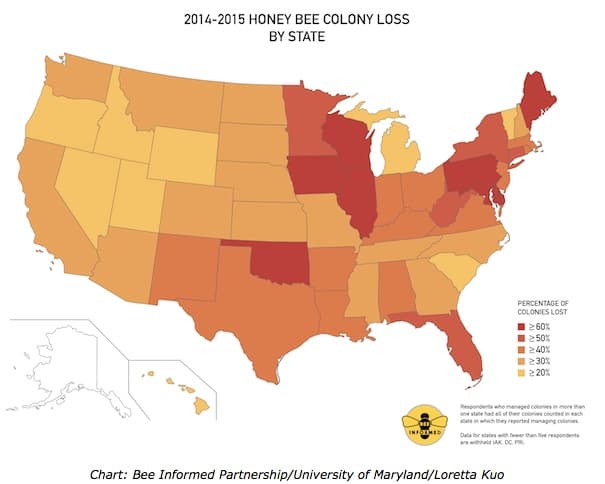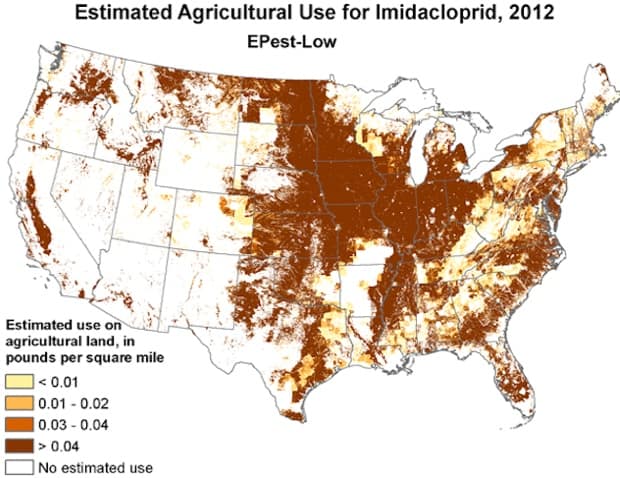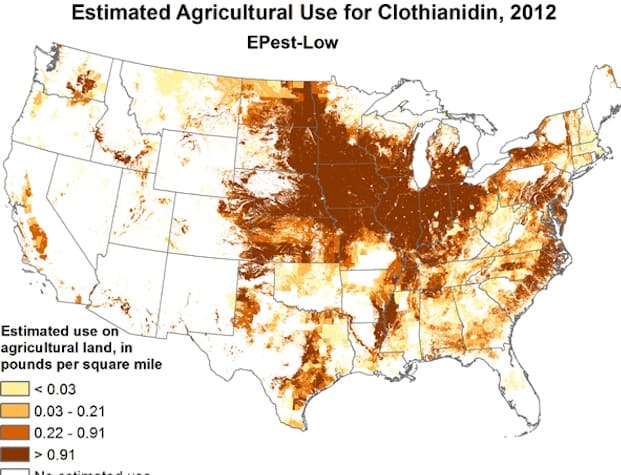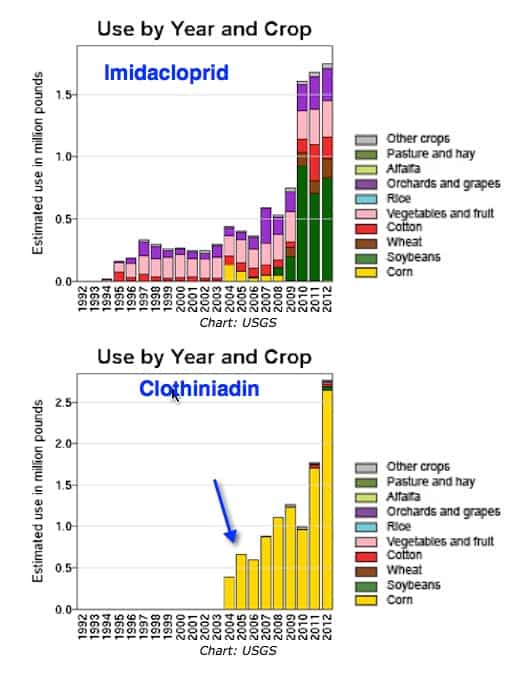This article was originally published for PeakProsperity.com's enrolled subscribers on 5/18/15. Given its importance, so many of them contacted us to make this post public that we are doing so today. ~ Adam
As you are aware, honey bees have been suffering from something called Colony Collapse Disorder. In practice, what this means is that the bees simply vanish from their hives, leaving behind their most precious worldly possessions: honey and larvae.
What causes these mysterious vanishing acts has been something of a mystery. But because the phenomenon began really ramping up in 2006, we can focus in on some suspects.
While it’s always possible that the bees are suffering ‘death from a thousand cuts’ -- where it’s no one specific thing but rather a wide range of minor insults, ranging from loss of forage to herbicides to fungicides to pesticides -- there’s actually quite strong evidence pointing to a specific class of pesticides called neonicotinoids.
This class of pesticides is massively and indiscriminately toxic. More specific to our investigation here, it was only introduced into widespread use shortly before the massive bee die-offs began.
Biocide = Suicide
Actually, it’s not really proper to call neonicotinoids ‘pesticides’ because they don't solely target pests. They should more accurately be called ‘biocides’ because they kill all insects equally and indiscriminately.
How toxic are they?
The neonics are so toxic that it's sufficient to simply lightly coat a seed with it before planting. When the seed grows to maturity, the plant will still have enough absorbed toxin circulating within its system to kill any insect that munches on it or sucks on its sap.
Think about that for a minute. Coat a kernel of corn with a neonic, sow it, and the mature plant will still be lethal to a corn borer when the corn ears develop several months later.
But not just to insects:
"A single corn kernel coated with a neonicotinoid can kill a song bird." As a long time environmental lawyer and campaigner, I should not have been stunned by that fact but I was. Shaking my head in dismay, I read on, "Even a tiny grain of wheat or canola treated with the ...neonicotinoid... can fatally poison a bird."
(Source)
Ugh. Boy, that depresses me -- thinking of the mentality in play that allows one to conceive of and then use such powerful poisons simply because one wants to engage in lazy farming. Hard farming requires knowing how to rotate crops, use beneficial natural relationships, and work intimately with the land on which you farm so as to minimize pest losses while maximizing the abundance of both your crops and the local ecosystem.
Sadly, the indiscriminate neonic killers are being used very widely. The mentality at play might as well be kill them all and let god sort them out. And therefore we are literally taking out whole swaths of life; both observed as in the case of the honey bee, and unobserved in the case of the many, many organisms not commercially or recreationally important enough to us to notice and track.
Killing off organisms in an ecosystem using indiscriminate biocides is quite literally a slow form of suicide for us humans. As within, so without. You cannot poison and kill of the world around you without poisoning and killing yourself.
Simply put: We are killing ourselves. And the data is literally horrifying.
The Birds and the Bees
If the thesis that neonics are harmful to both pests and other life forms alike is correct, then we should be able to detect those effects both with direct studies and indirect measurements.
Here’s where the horrifying part comes in. All of the data agrees: neonics are stone cold killers.
Insecticides Linked To Farmland Bird Population Declines
July 10, 2014
A new study in the journal Nature has found that use of neonicotinoids is linked to a decline in the populations of farmland birds across Europe.
For the study, scientists from Radboud University in the Netherlands and the Dutch Centre for Field Ornithology and Birdlife Netherlands (SOVON) analyzed long-term data for both farmland bird populations and chemical amounts in surface water. They discovered that in locations where water held high amounts of imidacloprid, a standard neonicotinoid, bird populations were known to decrease by an average of 3.5 percent on a yearly basis.
“In ten years it’s a 35 percent reduction in the local population, it’s really huge,” study author Hans de Kroon from Radboud University told Matt McGrath of BBC News. “It means the alarm bells are on straight away.”
The study team said the insecticide is probably coating seeds that the birds like to eat – as well as leaching into both water and soil around the sprayed areas. They added that neonicotinoids can persist in the environment for up to three years.
(Source)
Here we have a study that shows huge and dramatic negative impacts on bird life. A massive culling of more than a third of the bird populations in ten years is a really disturbing figure. In places where the water held high concentrations of neonics, bird populations were hit hardest.
The other interesting finding in the above the study was that the neonics were found in the water supply. They are not supposed to end up there, but they do, as we now know:
Bee-Killing Pesticides Found in Midwest Rivers
Aug 4, 2014
PESTICIDES LINKED TO declining bee and bird populations have been found in streams across the upper Midwest, raising yet more concerns about these chemicals’ environmental effects.
Researchers from the United States Geological Survey tested waters at nine sites in Iowa and Nebraska. They found neonicotinoids in each, frequently at levels that may harm insects and the life that depends on them.
“This wasn’t a toxicity study, but there’s research out there indicating that these concentrations could be of concern,” said USGS chemist Michelle Hladik, lead author of the paper describing the survey in the journal Environmental Pollution.
(Source)
Given just how toxic the neonics are, I have to wonder what the effect of them are on all the insect life that has water in its life stage: the mayflies, stoneflies and caddis flies. If these insects are killed, then you will find big declines in the bird populations that depend on those same insects for their food supply.
And/or if the insects are carrying sub-lethal levels of the neonic biocides in them, then the birds may be bio-concentrating the toxin to detrimental if not lethal levels in their own bodies.
I have to ask: What sort of a so-called ‘civilized’ nation, in this day and age, allows toxic levels of pesticides (or biocides as the case may be) to build up at hazardous levels in surface water in the first place?
What’s so important about selling a few bucks more to enable giant chemical firms and certain farmers to practice lazy farming that we’re willing to sacrifice the complete loss of critical elements of key ecosystems?
We may not tend to appreciate insects, but they are utterly and fabulously essential to everything we hold dear. You cannot just kill them all without upsetting the myriad finely-tuned systems of which both they and we are components.
While we have a lot of data on honey bees because they are commercially kept and tracked, the wild bees are not really tracked all that carefully. But we know enough to conclude that they, too, are suffering:
Neonicotinoid pesticides dramatically harm wild bees, study finds
APR 22, 2015
A common type of pesticide is dramatically harming wild bees, according to a new in-the-field study that outside experts say may help shift the way the U.S. government looks at a controversial class of chemicals.
But in the study published by the journal Nature on Wednesday, honeybees — which get trucked from place to place to pollinate major crops like almonds— didn't show the significant ill effects that wild cousins like bumblebees did. This is a finding some experts found surprising. A second study published in the same journal showed that in lab tests bees are not repelled by the pesticides and in fact may even prefer pesticide coated crops, making the problem worse.
Scientists in Sweden were able to conduct a study that was in the wild, but still had the in-the-lab qualities of having control groups that researchers covet. They used 16 patches of landscape, eight where canola seeds were coated with the pesticide and eight where they weren't, and compared the two areas.
When the first results came in, "I was quite, 'Oh my God,'" said study lead author Maj Rundlof of Lund University. She said the reduction in bee health was "much more dramatic than I ever expected."
In areas treated with the pesticide, there were half as many wild bees per square meter than there were in areas not treated, Rundlof said. In the pesticide patches, bumblebee colonies had "almost no weight gain" compared to the normal colonies that gained about a pound, she said.
(Source)
The bumblebees are essential to the overall state of the ecosystems of the world because they pollinate things that honeybees don’t. There is some overlap, but the bumblebees are able to reach deeper into certain flowers and have different platn preferences than honeybees, so they are not replaceable. They are unique contributors. If they go away, so will the many plants that depend on them for their life cycle.
And it gets worse:
Beyond Honeybees: Now Wild Bees and Butterflies May Be in Trouble
MAY 6, 2014
Among other pollinators, iconic monarch butterfly declines are well documented: Their numbers are now at a small fraction of historical levels. And entomologist Art Shapiro of the University of California, Davis spent most of the last four decades counting butterflies across central California, and found declines in every region.
These declines don’t just involve butterflies that require very specific habitats or food sources, and might be expected to be fragile, but so-called generalist species thought to be highly adaptable. Many other entomologists have told Black the same thing.
“Species that used to be in all our yards are dropping out, but nobody’s monitoring them,” Black said.
(Source)
It’s the butterflies, too. Certainly in my own personal experience, I’ve noticed a lot fewer butterflies in my backyard over the past several years. We plant flowers specifically for bees and butterflies, so I'm something of a casual tracker of their types and numbers.
Even more recently, we have solid data showing a dose-response where the heaviest neonic use correlates with the heaviest honeybee die-offs:
Bee Die-Offs Are Worst Where Pesticide Use Is Heaviest
May 14, 2015
The nation’s honeybee crisis has deepened, with colony die-offs rising sharply over last year’s levels, the latest survey from the US Department of Agriculture-funded Bee Informed Partnership shows. A decade or so ago, a mysterious winter-season phenomenon known as colony-collapse disorder emerged, in which bee populations would abandon their hives en masse. These heavy winter-season losses have tapered off somewhat, but now researchers are finding substantial summer-season losses, too.
And here’s a map a map depicting where losses are heaviest:
(Source)
The article goes on to cite much of the direct as well as circumstantial evidence we have that these biocides are the culprits for much of the damage cited above. Take a look at both where the usage of the neonics is heaviest and when they began to be used in earnest (charts below) and then recall that the bee, butterfly, and bird declines all began around 2006 and have gotten measurably and drastically worse in the last few years.
Hmmmm….seems to me that in any court of law, and in the mind of any reasonable person, there’s enough evidence here to say that there’s a very big problem and the neonics are the likely culprits.
One bird that I’ve always loved in the Sparrow Hawk, or American Kestrel as it is now more properly called. The smallest of the hawks it is brightly colored and was a very prominent bird of my childhood. They used to be everywhere.
Now they are quite scarce in my area. And because nobody makes any money off of them, only a few ‘birders’ seem to notice or care.
But these mainly insect-eating birds are in serious decline:
American Kestrel Population Drops Dramatically, And Without Fanfare
Jul 29, 2014
On a national level, the American kestrel (Falco sparverius) population has been plummeting. Records from the North American Breeding Bird Survey, a massive annual data collection effort for more than 400 bird species overseen by the U.S. Geological Survey (USGS) and the Canadian Wildlife Service, show the kestrels have declined by an estimated one and a half percent each year between 1966 and 2010. The long-term loss is almost 50 percent of the population. That’s a big drop for a bird considered abundant in North America.
A handful of things could be causing the lower kestrel numbers, bird biologists say, including increased predation by Cooper’s hawks, continued exposure to pesticides, and competition at nesting sites by European starlings.
(Source)
Every biologist struggles to explain the massive losses in their chosen area of study due to ‘natural causes.’ But the easier and more obvious choice is ‘humans are doing something, and it’s killing off this thing I am studying.’
So when we put all of the above together, it's obvious that Rachel Carson’s Silent Spring has taught the US EPA and businesses nothing at all.
You would think that in the wake of the DDT disaster that we’d be more careful. But that’s just not the case. The exact same mistakes are being made here again. And it is beyond a tragedy because this time it’s being done with our full awareness.
Obviously, the sorts of environmental impact and toxicity studies that were supposed to be done were either forgone, or done fraudulently.
The Response
After a lot of hue and cry, and years and years of solid studies and accumulating evidence, the EPA finally took a stand and issued new firm rules for the neonics.
However, don't just scan the headlines because you’ll end up with the wrong impression.
Read more carefully:
EPA Restricts Use of Pesticides Suspected of Killing Bees
Apr 2, 2015
The EPA has issued a moratorium on use of a type of pesticide theorized to be responsible for plummeting bee populations. Neonicotinoids are a class of common pesticides that recent research has pointed to as being harmful to birds, bees and other animals.
The EPA previously approved their use, but outcry over the damage being done has caused the agency to reverse course while more studies are done. On Thursday, the EPA sent letters to people and companies that have applied for outdoor use of the pesticide, saying that new use permits won’t be issued.
New uses of neonicotinoids will no long be approved “until the data on pollinator health have been received and appropriate risk assessments completed,” the EPA letter reads. Existing permits to use them, however, will not be rescinded — something wildlife and environmental advocacy groups are unhappy with.
(Source)
The headline implies that the EPA is now limiting the amount of neonic being used but that's not the case at all. As a result of their 'ruling' even more could be used in the near future, or maybe less, but the ruling itself does nothing to restrict how neonics are currently being used because it only applies to 'new' uses.
Are you kidding me? This represents the ‘middle ground’ the EPA sought?
Every single current use of neonics will continue. By the way, one “use” is using neonics to treat corn. Or wheat, or any other already approved “use.” Those use maps above will continue unabated while the EPA 'studies' the issue, a process that could take a decade or more.
The ruling means that farmers newly considering using these biocides will not be blocked in any way shape or form as long as they are going to use them in a way that's already approved.
So, the exceptional and mounting damage will continue.
This is pathetic, and it is an outrage. It represents everything that is wrong with America today.
There is both economic damage being done to beekeepers and everybody who depends on their services, and there is massive environmental and ecosystem damage being done. The EPA has ruled that a few hundred million dollars of sales for major chemical companies outweigh every other right in this story, including the basic right of all life to simply live.
[Note for subscribers, this is a new set of paragraphs inserted to keep up with recent developments]
More recently, the Obama administration has unveiled the results of a task force meant to study the plight of the pollinators and make recommendations on how to support them.
How the White House plans to help the humble bee maintain its buzz
May 9, 2015
On Tuesday, the Obama administration will announce the first National Strategy to Promote the Health of Honey Bees and Other Pollinators, a bureaucratic title for a plan to save the bee, other small winged animals and their breeding grounds.
The strategy, a copy of which was obtained by The Washington Post, will seek to manage the way forests burned by wildfire are replanted, the way offices are landscaped and the way roadside habitats where bees feed are preserved.
“What are we doing on bees?” Obama asked Holdren as they prepared to wrap up an Oval Office meeting in the summer of 2013. “Are we doing enough?”
That discussion led to the launch of the White House Pollinator Health Task Force, whose recommendations are being unveiled Tuesday.
CropLife America chief executive Jay Vroom, whose group represents pesticide manufacturers and participated in the task force, said that while his members might disagree with the EPA at times, they’ve “continued to be science-based and balanced” at the agency.
Not at all surprisingly, given the fact that we have 8 years of increasing and highly obvious evidence of neonicotinoid inflicted damage, the Obama task force came out with recommendations to study pesticides for a few more years and then devote a couple of nickels and a lot of lip service to increasing ‘habitat.’
I know that the task force came up with diddly squat because the main pesticide promoting trade association representing the manufacturers of pesticides and other agricultural chemicals, the ill-named CropLife America, loved the resulting recommendations.
That’s all I need to know that this task force was a joke, came up with nothing useful, and ended up protecting narrow economic interests as opposed to protecting broad life supportive aims.
The very idea that it’s habitat that’s at fault here, rather than the chemicals is just another insult to everyone of reasonable intelligence.
The American Way
I find it increasingly difficult to believe in the things the country in which I live stands for.
In Germany, where the various interests are more carefully balanced, and where people and beekeepers actually have some say, things are very different.
From 2008:
Germany bans chemicals linked to honeybee devastation
Germany has banned a family of pesticides that are blamed for the deaths of millions of honeybees. The German Federal Office of Consumer Protection and Food Safety (BVL) has suspended the registration for eight pesticide seed treatment products used in rapeseed oil and sweetcorn.
The move follows reports from German beekeepers in the Baden-Württemberg region that two thirds of their bees died earlier this month following the application of a pesticide called clothianidin.
"It's a real bee emergency," said Manfred Hederer, president of the German Professional Beekeepers' Association. "50-60% of the bees have died on average and some beekeepers have lost all their hives."
Tests on dead bees showed that 99% of those examined had a build-up of clothianidin. The chemical, produced by Bayer CropScience, a subsidiary of the German chemical giant Bayer, is sold in Europe under the trade name Poncho.
(Source)
Several things are fascinating here. First, the neonic clothianidin is actually manufactured by a German company, and it’s the same company that sells the stuff in the US. You’d think that, if anything, the German government would work harder to protect the economic interests of its own companies more than the US EPA. But you’d be wrong.
Second, this was way back in 2008. German beekeepers had one very bad incident with the chemical, the appropriate tests were run, the risk was deemed unacceptable and the pesticide was yanked from the market.
That’s how these things are supposed to work.
Yet in the US, it is now seven years after that and the EPA has only gotten around to nixing new uses for the compounds that are now widely used and destroying insects and birds across a huge swath of the country.
Even if it would cost somebody a whole lot of money, and maybe even make farming a touch less lazy and require more effort, I would personally favor banning every and any pesticide and herbicide and fungicide until all of the appropriate long-term toxicological studies had been carried out. They are not that difficult to run, they just cost money and take time.
No ‘grandfathered’ uses. No exceptions. Prove the stuff is safe or else it cannot be sold or used.
But that’s because I would choose life over money. And that’s apparently where I part ways with my country, at least as far as the US government is concerned.
Unintended consequences
The prediction here is easy enough to make. The law of unintended consequences is going to rear up and bite us. Again.
One cannot simply wipe out entire swaths of insect and bird populations without causing eventual and massive difficulties.
One day we’ll wake up and wonder why some pest has gotten totally and uncontrollably out of hand. And if we chase it down, we’ll discover some beautifully complex natural cycle that involved a host species, a predator, a plant and animal and a few other creatures that used to dance to a song that had been written and perfected over a hundred million years of evolution.
Break the dance, and you break the web of life.
Mark my words, ‘insects’ is going to become a very hot topic over the next few years. And my sincere hope is that we do not destroy too much and that we figure this out before it’s too late.
For now, all I can say is: Shame on you, EPA. Deep, and lasting shame on all of you.
Conclusion
All of this leads me here: We desperately need a new narrative.
The old one not only allows but encourages the neonic story, and a hundred others just like it, to take root and flourish.
We cannot begin to fight each battle -- neonics and fracking waste water disposal and leaking Gulf of Mexico wells and money in politics – and hope for anything more than a slight delay of the arrival of our miserable end.
Instead we have to have a new narrative where it is emotionally impossible for an EPA staffer to approve neonics because they would be too horrified to do so. I could not use them, but that's because I have an internal narrative that values all life.
While I certainly think people should fight these battles, those skirmishes are for naught if another crew (that’s us) is not paving the way for that new narrative at the same time.
If we were to have a new Declaration of Independence, it might start with these words (from our group effort):
"We hold these truths to be self-evident, that all people are created equal and that all life is sacred. That all people are endowed by their Creator with certain unalienable Rights and Responsibilities. That among these Rights are Life, Liberty and the pursuit of Happiness, and among these Responsibilities are to live in Harmony with Nature, to be Stewards for the Natural World, and to leave a World Worth Inheriting to our Posterity."
I am sickened by the damage being done by the neonics and I am dismayed by the pathetic and weak response by the so-called regulators at the EPA.
In a healthy culture these people would be packed off to new jobs, and they would be shunned by thoughtful people until they had atoned for their ridiculous actions.
But that is not yet the world in which we live.
A more subtle point to be made here is that each of us needs to prepare for the fact that the people in authority, even when confronted with compelling and obvious data, will choose to put profits over life and favor doing nothing over something.
In short, stories like this one cement my view that we face a future that will be shaped more by disaster than design, and that we each need to prepare for that as best we can.
~ Chris Martenson
This is a companion discussion topic for the original entry at https://peakprosperity.com/suicide-by-pesticide/






